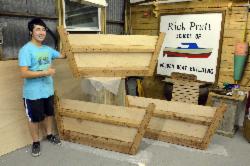
Having spent a full three days of my son Joey’s summer vacation at Farley Boat Works in Port Aransas we were bone tired from helping build forward stems and transoms,. Learning to build a wooden Farly boat at the Rick Pratt School of Wooden Boat Building under the direction of Shop Master Darrell Lynn was hot, sweaty, difficult and rewarding.
We broke from our boat building to spend some time with my mother back in Fredericksburg who was recovering from a recent health setback. As we told her our tales of wrestling with wood our confidence grew with each tidbit until I am certain we sounded like we had sawdust in our veins. Mom assured us she wanted us to get back to work on the boat so she could go fishing with us as soon as possible.
So with a full measure of hubris on my part, my son remaining quite humble, we journeyed back to Port Aransas leaving San Antonio at 6am on Monday morning only to find out the Farley Boat Works is closed on Sundays and Mondays.
The following morning I struggled a bit getting out of bed knowing there was another long hot day ahead of me. Joey is a rugged 17 year old and needs no encouragement for lacrosse, hunting, food or sleeping late. A text message from Darrell appeared asking us where we were. It was already 7:05am so we navigated the morning rush hour of Port Aransas traffic which consisted of a ten year old kid driving a golf cart past our driveway.
Darrell welcomed us back the shop where over tacos and coffee we listened to the game plan he was laying out for us. There would be two boats getting built, ours and another that would be auctioned off to help raise money for muscular dystrophy research. "You are going to be working with a lady from around Abilene who is building the other boat. She’s going to be a big help even though she is green just like you guys." We nodded our support.
It was about that time the lights in the shop started flickering, the wind kicked up and the palm trees outside swayed as a force of nature walked into the boat shop. Wendy Shack stands a little over 5 feet tall. Her southern drawl is as authentic since she is originally from Alabama. A smile rarely leaves her face and she carries an abundance of enthusiasm.
"Hi y’all." Wendy said. "Let’s build some boats!" I couldn’t help but notice the manicured nails and thought to myself this party was about to get real. Any reservations I had about Wendy’s ability to hold her own and work as hard as anyone else were soon dispelled. She wasn’t there for show, she was there for dough. She wanted to build a boat to help fund the research to find a cure for MD going. She is motivated and volunteers year round for the cause helping her would be an honor.
Darrel had us take one of the 15’8" x 4’ lengths of plywood we had scarffed the week before to the table saw where he cut it in half lengthwise. We laid the two pieces on the floor.
"Who’s mixing the epoxy?" Darrell asked. I grabbed a plastic container and started mixing.
Here is some very sound advice about epoxy. Always wear rubber surgical gloves from the first moment you handle it so you develop the habit of wearing gloves. There are health concerns from it contacting your skin over time. Boat building will get plenty of epoxy on your hands and clothes. Combined with saw dust from dark mahogany wood your hands will stain. Quickly washing your hands with vinegar helps. But your hands will stink. Wear gloves.
In front of the boards we placed the stem and to the rear the transom. The stem had started out as three boards of different widths about three feet long glued one on top of the other. They were then run across the table saw to create a single board that when looked at from either end somewhat resembles an arrow sign.
Wendy marked a two inch strip and then every few inches a another mark was placed for screw holes on both ends of the side board. Joey grabbed the drill and pre-drilled the holes where marked.
Darrell applied the epoxy to the lower side of the stem and the plywood inner side where it would meet the stem. He then grabbed the drill and some wax dipped screws.
At that moment fellow boat builder Ernie Jamison walked into the shop. "Hey, Ernie, c’mere, you can help us." Darrell called out. Ernie knelt down and grabbed a sideboard.
Attaching the sides of the boat to the stem is critical. It must be done right. If you get it wrong you have but a few minutes to get it right before the epoxy hardens. Starting from the bottom inside corner both the port and starboard side boards must be lined up on the stem’s angle from the bottom up. This insures the boat will have when it meet the water. Proper fit is essential.
This point is the most exciting progress in building a boat. The transom is stood up on end, epoxy is applied to it’s sides and the rear inner sides of the side boards. The parts are aligned from the bottom up and screwed in place. A pre-cut spreader jig is fitted upright into the middle of the bottomless boat giving the boat girth and the sides are screwed to it.
Darrell yelled over the happy chatter that had broke out among all of us. Eyebrows were raised and faces resembled question marks. "Get the saw horses, let’s flip it."
Next installment The Farley Boat Builders splash Charlie’s Dragon Fly, combine music, rowing, fried ice cream and manage to build boats in between.